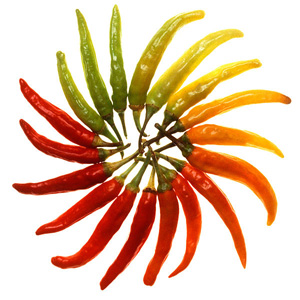 In an article posted on The Atlantic’s website last week, Gary Paul Nabhan, co-author of Chasing Chiles: Hot Spots Along the Pepper Trail, addressed the relationship between farming in the Southwest and climate change—both food production and food security have been cast into question with the growing scarcity of water and unpredictable growing seasons and weather patterns, such as drought.
In an article posted on The Atlantic’s website last week, Gary Paul Nabhan, co-author of Chasing Chiles: Hot Spots Along the Pepper Trail, addressed the relationship between farming in the Southwest and climate change—both food production and food security have been cast into question with the growing scarcity of water and unpredictable growing seasons and weather patterns, such as drought.
Nabhan points out that with water capacity near its limit for cities and rural agricultural areas, “food security in the Southwest depends upon the security of water supplies being delivered to irrigable land. That capacity, we can now see, has been severely impaired by urban growth in the Sunbelt since World War II, and is likely to be further impacted by the vagaries of weather shifts.”
The burden of addressing such trends, says Nabhan, falls on both the consumer and farmer, and individual responses may not be enough to reverse the trends. Sustainable agriculture and good farming practices may be the best way to counter the growing threat of food security in the region.
In Chasing Chiles, Nabhan, along with co-authors Kurt Michael Friese and Kraig Kraft, set out to discover the history and potential of America’s heirloom chile varieties. Their journey reveals the chile pepper’s dynamic role in understanding climate change and the future of food production.
So how can food producers and eaters in the Southwest improve their “foodprints?”
“Eat and farm as if the earth matters, as we should have been doing all along,” says Nabhan in Chasing Chiles. “Regardless of how quickly we can implement the specific fixes proposed to mitigate climate change, we all need to reduce our carbon [footprint] and adapt to change in ways that keep the earth’s bounty as diverse, as delicious, and as resilient as possible.”
As an orchard keeper and chile grower, Nabhan has committed to do his share to curve the growing trend of climate change by conserving water between rainfalls, growing regional-appropriate crops, such as drought and heat-tolerant heirlooms, and soil-building.
For the rest of us, Nabhan, Friese, and Kraft have these suggestions in Chasing Chiles:
- Explore, celebrate, and consume what diversity can be found locally.
- Farmers’ knowledge and problem-solving skills are assets for coping with and adapting to climate change.
- Eaters (chefs and consumers) need to vote with their forks, wallets, and ballots in support of more diverse and regionally self-sufficient food systems.
- Climate change is best dealt with as one of many compounding factors, not as an environmental impact apart from all others.
- Empower local food communities to be “co-designers” of local solutions to global change, and then to creatively transmit their solutions to other communities.
If nothing else, says Nabhan, “I get down on my knees and put my hands into the earth.”
Read more about the history of chiles in America, and their tenuous relationship with biodiversity and climate change in Chasing Chiles, available at Amazon. Click here to read the full article from The Atlantic.
Look for an excerpt and review of Chasing Chiles in the July issue of Burn! Magazine.
Sources:
“Farming in the Time of Climate Catastrophe,” by Gary Paul Nabhan, www.TheAtlantic.com
Chasing Chiles: Hot Spots Along the Pepper Trail, by Kurt Michael Friese, Kraig Kraft & Gary Paul Nabhan, © 2011 Chelsea Green Publishing
Kelli Bergthold
Latest posts by Kelli Bergthold (see all)
- Celebrate Mexico’s Colorful Cuisine & Culture on Cinco de Mayo - 04/26/2013
- Why NOT Eat the Easter Bunny? - 03/22/2013
- Improve Your “Foodprint”: Farming and Climate Change - 04/25/2011








Comments
Pingback: Improve Your “Foodprint”: Farming and Climate Change | « Chasing Chiles